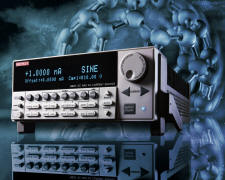Keithley Instruments, Inc.
With more than 60 years of measurement expertise, Keithley Instruments is a world leader in advanced electrical test instruments and systems that solve emerging measurement needs. Their customers are scientists and engineers in the worldwide electronics industry involved with advanced research and product development in areas such as nanotechnology, semiconductors, and the production of end products such as portable wireless devices.
Links:
Interview:
Q: In which Countries does your organization have a presence?
Keithley does business in all the major developed countries, and has offices in several European and Asian countries.
Q: How many employees do you have?
Keithley’s employment currently exceeds 500 persons.
Q: Please provide a short paragraph outlining the history of your organization.
Since 1946, Keithley Instruments has been engineering the future of test technology. The company was founded by Joseph F. Keithley, whose contr ibutions to measurement science led to groundbreaking technologies. The company’s earliest electronic measuring devices, such as electrometers and picoammeters, were ideal for measuring low level electrical signals precisely and were sold to scientists and physicists in laboratories around the world. Over the years, Keithley has extended its measurement technology to create innovative solutions for nanotechnology, semiconductors, radio frequency (RF) devices, and other segments of the electronics industry. Keithley is consistently recognized as a leader in electronic measurements, and has won many awards for its innovations.
Q: Explain the role of nanotechnology in the development of your organization or department.
Keithley is helping advance the state of the art in a growing list of nanotechnology applications. Six decades of experience in designing ultra-sensitive measurement tools allow us to provide university, corporate, and government labs around the world with solutions for investigating new material and device properties. Just as important, these solutions are designed so that users get the results they need quickly and simply. That means they can focus on research and development, not on the test hardware. Keithley partner’s with organizations like the Institute of Electrical and Electronics Engineers (IEEE), the IEEE Nanotechnology Council, IEEE Standards Association, leading Nanotechnology Centers of Excellence, Keithley customers, and other leading nanotechnology measurement tool vendors to create more complete solutions and measurement methodologies. The insight into emerging needs that these working partnerships provide helps Keithley deliver new capabilities faster.
Q: What key markets do you serve?
In addition to government, university, and private industry labs conducting nanotechnology research, Keithley serves diverse markets with instrumentation and automated test systems. These include:
- Telecommunications
- Semiconductors
- Optoelectronics
- Aerospace & Defense
- Automotive
- Electronic Component Manufacturing
- Computers and Peripherals
- Flat Panel Displays
- Medical Electronics
Q: How has nanotechnology impacted the products or services you provide?
Nanotechnology research is advancing so rapidly that many scientists find existing measurement instruments lacking in the sensitivity and resolution needed to characterize low-level signals effectively. Therefore, nanotechnology has created a growth opportunity for Keithley to provide electrical measurement tools that researchers and scientists need for making precision low-level measurements on advanced materials and the next generation ‘beyond CMOS’ nanoelectronics. Understanding how building block materials like nanocrystals, nanotubes, nanowires, and nanofibers will perform in tomorrow’s electronics demands instrumentation that can characterize resistance and conductivity over wide ranges. Keithley combines all the necessary sourcing and measurement tools into a variety of easy-to-use test solutions. Many are designed for easy integration with other instruments to extend system ranges and capabilities even further. New materials, miniscule device dimensions, and higher operating speeds have all combined to make characterizing nanostructures more challenging than ever. Traditional DC current vs. voltage (I-V) techniques can lead to joule heating of the device, affecting device response and masking the phenomenon of interest, or even destroying priceless experimental devices. By minimizing the amount of energy pumped into a device, Keithley’s growing line of pulse testing solutions offers valuable alternatives to DC characterization methods. Both DC I-V and Pulse I-V have allowed the researcher and scientist to better study how next-generation nanoelectronics like carbon nanotube field-effect transistors (CNTFETs), single electron transistors (SETs), and other exotic devices will perform under a variety of conditions. Emerging applications in nanoscience will continue to create opportunities for Keithley to develop new instrumentation that enables scientists and researcher to be more productive, and thereby achieve their goals with speed and simplicity.
Q: Has your organization made any significant contributions to nanotechnology?
Through our partnerships, Keithley has made significant contributions to nanotechnology, and has been recognized in the following areas:
- Keithley Instruments co-authored “IEEE 1650TM-2005: IEEE Standard Test Methods for Measurement of Electrical Properties of Carbon Nanotubes”
- Keithley Instruments co-chairs the IEEE Nanoelectronics Standards Roadmap (NESR) Initiative
- Jonathan Tucker is the 2008-2009 IEEE Nanotechnology Council Standards Committee Chairman
- Keithley Instruments was the Exhibits Chair for IEEE-Nano 2006.
- Keithley Instruments is an Associate Member of the California NanoSystems Institute (CNSI), contributing the development of technology and academic excellence in Nanoelectronics.
- Keithley Instruments, working in conjunction with the NanoBusiness Alliance, affirmed its support for the reauthorization of the 21st Century Nanotechnology R&D Act in 2008.
Q: Briefly describe a current project involving nanotechnology, and what your anticipated outcome will be (new process, new product, etc.)
Through its many partnerships and relationships, involving some of the best nanoscience institutions around the world, Keithley and its partners are working to develop new instrumentation and measurement techniques that will solve emerging measurement problems. Currently we are working on measurement challenges in areas such as nanoelectronics, spintronics, graphene electronics, alternative energies, and advanced materials.
Q: Where do you see nanotechnology applications leading in the future?
Keithley believes that the leading applications of the future will be in nanoelectronics, advancements in health care, and in alternative energy. Consumers are constantly demanding feature rich electronic products that are faster and in smaller packages. This is very clear, for example, with Apple’s line of iPhone’s. The iPhone is a remarkable consumer electronic product that combines communications, entertainment, and navigation in a very small form factor. Products like the iPhone and the iPod require sophisticated electronics on a much smaller scale. Consumers will continue to demand these types of technology driven products, which will require the next generation of ‘beyond CMOS’ nanoelectronics. The second key application is the advancement of health care. Nanotechnology will be a key enabler in the development of health care where nanoelectronics will be a critical component. Implantable devices with radio and video communication capabilities will allow medical practitioners to diagnose patients faster and with greater accuracy, even from remote locations. Nanoscale systems will be developed that enable the delivery of drugs to combat cancerous tumors and other diseases, creating a better life for all. Such drug delivery systems may require biocompatible nanoelectronic systems and power from nanobatteries in order to facilitate effective solutions for curing diseases. The third application is alternative energy. The world’s energy demands are increasing at a rate much faster than before, causing certain fuels like oil to increase in price at the fastest pace ever. To reduce dependency on fossil fuels, extensive research in alternative energy is taking place in areas such as solar cells and fuel cells. Nanotechnology will be a key enabler in these areas. The development of unique nanomaterials that have higher conductivities will help drive down the costs of fuel cell technology, making it a viable energy alternative. Advancements in nanomaterials will enable solar cells to convert light into electricity at much higher efficiency, making them a cost-effective solution. Already we are hearing about start-up companies that plan to develop solar panels that can be rolled onto the roof of a house, making the home more energy independent.
Q: What advice would you offer to someone who wanted to work at your organization in 3-5 years?
Stay abreast of the latest in electronics technology and measurement methodologies. A solid understanding of the latest semiconductor fundamentals is also very helpful. As the semiconductor industry moves from a sub-micron technology to the quantum scale, understanding how electronics will perform at the quantum scale will also be important.
Q: What industry do you think has been impacted the most by nanotechnology thus far? Why?
The early benefactors of nanotechnology have been the instrumentation and tools industry. Without good tools and instrumentation, nanoscience would not be where it is at today. The demand for better tools will continue and we will continue to see additional innovations in measurement technology that allow scientists and researchers to push the envelope of nanoscience and make new discoveries that benefit society.
Q: What industry do you think has the greatest future potential to be impacted by nanotechnology? Why?
The semiconductor industry has the greatest potential to be impacted by nanotechnology. This industry has been driven by Moore’s Law, which states that circuit density is doubled every 18 months. In order to maintain this rate of increase, there must be a fundamental change in the way circuits are formed. The cost to develop a new semiconductor fabrication facility is well over $1Billion. This includes the cost to build the facility and purchase the highly expensive fabrication tools that create the integrated circuit electronics we take for granted today. Many within the semiconductor industry are recognizing that the end of Moore’s Law may be near with our current fabrication technology. The International Technology Roadmap for Semiconductors is already recognizing this and now includes nanoelectronics and other ‘beyond CMOS’ architectures and systems as possible solutions to extend Moore’s Law. Without nanotechnology, the industry will be severely challenged in its continuing efforts to improve the performance and cost of sophisticated semiconductor devices. Thus we believe that nanotechnology will play a major role in the continued growth of one of the largest industries in the world.


